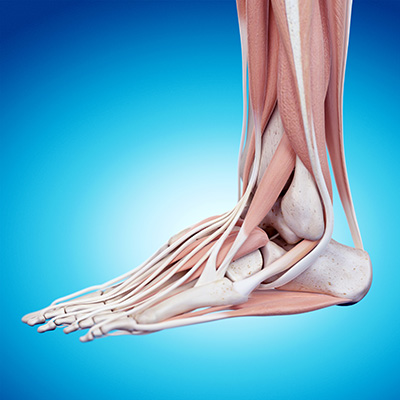What Is Peroneal Tendinitis?
There are two peroneal tendons about the lateral ankle and midfoot. The muscles from these tendons are on the outside or lateral aspect of the calf. The tendons extend down along the outside of the ankle bone and then pivot down toward the outside of the foot. One of the tendons attaches at the base the fifth metatarsal and outside of the foot, and the other extends across the bottom of the foot.
These tendons function to allow the foot and ankle to rotate to the outside or lateral aspect. This is the movement that would be required to help prevent an ankle injury–inversion injury. This muscle and tendon complex also functions to stabilize the foot in a normal gait. Tendonitis can occur when these tendons become overused or damaged.
Causes
 Peroneal tendinitis is often an overuse injury. Individuals with a high arched foot or who bear a lot of weight on the outside of the foot are at greater risk, as this puts more tension on the peroneal tendons. In addition, when the ankle has an inversion injury, the tendons can be strained, over-used, or partially torn. In some of these situations, there is an injury to the attachment site at the fifth metatarsal, or even a fracture here. It is interesting that some resistant cases involve a low-lying muscle belly that extends much farther than typical down the outside of the leg; this may require surgical revision.
Peroneal tendinitis is often an overuse injury. Individuals with a high arched foot or who bear a lot of weight on the outside of the foot are at greater risk, as this puts more tension on the peroneal tendons. In addition, when the ankle has an inversion injury, the tendons can be strained, over-used, or partially torn. In some of these situations, there is an injury to the attachment site at the fifth metatarsal, or even a fracture here. It is interesting that some resistant cases involve a low-lying muscle belly that extends much farther than typical down the outside of the leg; this may require surgical revision.
Symptoms:
With peroneal tendinitis, there is usually pain on the outside of the ankle or the midfoot. This can be more noticeable on uneven surfaces. This may be the type of problem or pain that occurs only with certain activities such as running, tennis or other side-to-side exercise sport or activities. There may be associated swelling.
Diagnosis:
The diagnosis can be made with a combination of physical examination at the clinic, ultrasound imaging, and or MRI. X-rays can be helpful if there is calcification within the tendon or injury that involves the fifth metatarsal base attachment site.
Treatment:
In severe or acute cases a cast boot or non-weight bearing is required.
• Special braces the can help protect and decrease the workload on the peroneal tendons.
• Prescription orthotics treat the biomechanics that overload and overuse the peroneal tendons. So this is part of the long-term management.
• Shockwave therapy.
• In some situations, surgical repair is needed.
• Physical therapy can also be helpful.
Subluxation of the peroneal tendons about the outside of the ankle or lateral malleolus is another similar problem. This is where the tendons slip out of the typical groove in the ankle bone and do not function correctly. This often requires surgery.






